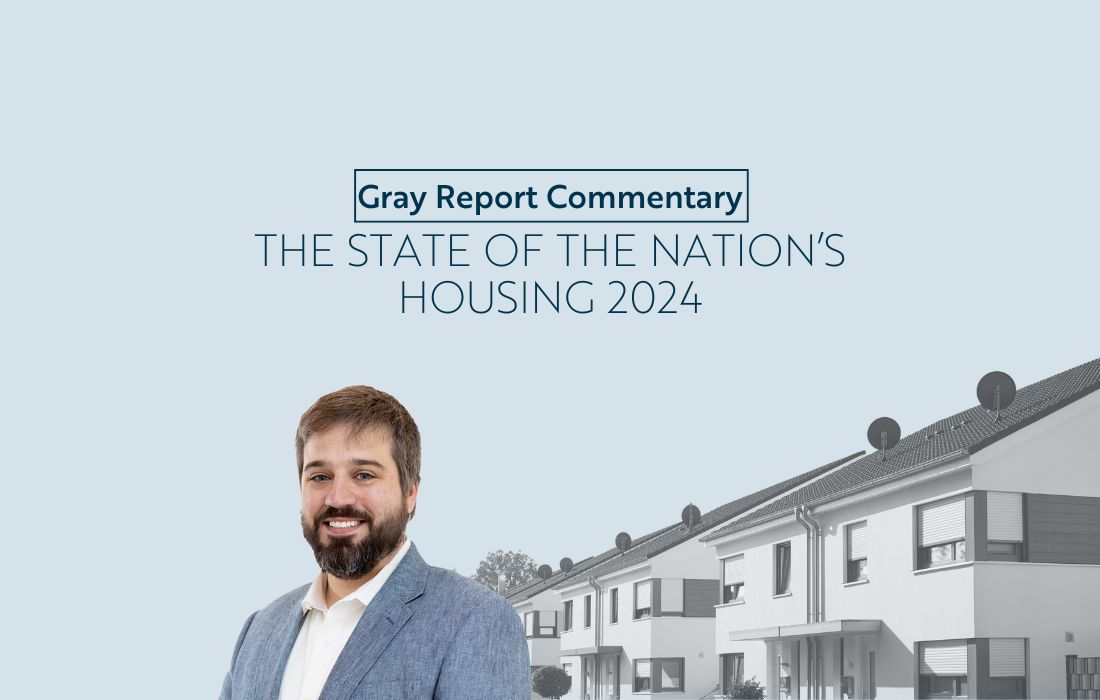
The State of the Nation’s Housing 2024
Source – Harvard Joint Center for Housing Studies: “The State of the Nation’s Housing 2024”
This is a big one, and we’ll likely be digging into this and discussing it in future episodes of the Gray Report, but we’ve got an overview of the main points to discuss today, and we kindly direct our audience to the show notes for this episode, which includes a link to this 48-page report from the Harvard Joint Center for Housing Studies.
Main points:
Housing costs continue to rise (case-shiller is still going up, according to recently-released data)
Cost burdens are going up, with a growing number of people paying more than 30% of their annual income on housing (with renters having more housing-cost-burdened individuals than home buyers, as a group). Additionally, housing mobility is still going down, although this is driven by homeowners not moving out due to high interest rates
Household growth (still) high: This is very good news. I see households as a really salient indicator of housing demand, really the downstream effects of economic growth, population growth, income growth, and all the primal forces that actuate the housing market down the line. If you skip to page 18 of the report, you can see that, despite maybe some worry about demographic shifts away from the huge number of baby boomer households into the smaller gen x, millennial, and gen z households, the household numbers are appreciably bigger now than they were in the 2010s.
New units soften the rental market: We know this. But this is the Harvard Joint Center for Housing Studies, I know that we’re not going to get much emphasis on the lower rent growth that followed from the surge of new apartment units built. It can both be true that rent growth was stagnant for a year and housing (including rental housing) is unaffordable for many people
- A graph on page 29 sheds some light on this issue, but significantly, 2022 is the latest year for which they have information. That was peak rent growth year. Really interested to see what these charts look like now, because it’s not just simply that these graphs are out of date, but their out-of-date-ness happens at a specific inflection point where the trends for rent growth changed significantly, which could mean that the cost burdens on renters are lessening.
- But what about this: Let’s say rent growth is flat for a whole year. That’s what the private rent growth trackers have recorded, even if those number have not been fully realized in the CPI, which typically lags the private rent trackers by a year. So, let’s just say, hypothetically, you get rent growth that’s closer to flat. The wage growth for the lowest quintile of workers is at 4.9%. If rent growth is lower than 4.9%, wouldn’t that mean that a lower number of individuals are cost-burdened? Now, wage growth is falling since its peak in late-2022 and early 2023. But so is rent growth as measured by the CPI. Rent of primary residence is at 5.3% annual price growth, so it’s going to be worth watching for these numbers to flip, with wage growth jumping ahead. With CPI-measured rent growth set to decline, it seems like we could be headed to a more affordable rental situation, barring serious wage growth declines.
Low for-sale inventories lead homebuyers toward new homes: We haven’t covered the for-sale housing market in as much depth relative to the apartment market, but this trend is understandable given the high interest rates that are discouraging people from selling their homes and having to get a mortgage at a much higher interest rate. The amount of time that we’ve had low interest rates has created a huge pool of people that are disincentivized in this way.
Homeownership increasingly out of reach: Yes. Purchasing a home is more expensive. I wonder what we could do to solve this problem? (build more housing ?) The gap between renting and homeownership is growing, homeowners’ household wealth and available cash grew faster than that of renters. I’m not 100% sure, but I think that there’s some wiggle room in these numbers. I know that they’re going by median income here, which helps to off-set the millionaire and billionaire homeowners, but I’d like to see a comparison that’s a little closer to the transition point between renter and homeowner. What about homeowners that have recently purchased a starter home? That might show a smaller gap, but there is no doubt that this, jeeze, it’s more of a gulf than a gap, the gap, canyon, or whatever you call it, it’s real, and that’s not even bringing in interest rates as a huge barrier to homeownership.
Barriers to narrowing racial homeownership gaps persist, but notably, during the pandemic, there were some incremental gains, with black and Hispanic homeownership rates outpacing the US average during the pandemic.
Expanding the safety net: A clear call from the Harvard Joint Center for Housing Studies here: “Federal funding has not grown to meet the rising need,” which is valid. It’s a little frustrating that they don’t really mention housing supply when they talk about funding here. But, there is a large section of the report that covers “Unlocking the Constrained Housing Supply,” (page 38) and addresses the financing, zoning, and regulatory barriers that are making it difficult to build new housing.
